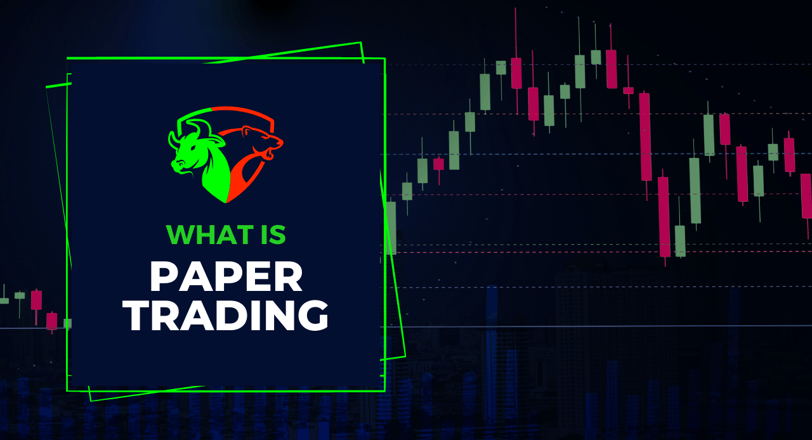What is Paper Trading? Importance & Benefits of Paper Trading
Paper trading simulates stock trading without risking real money. Understand its definition, significance, and differences from live trading. Know more!
MARKETING


In the dynamic realm of stocks and trading, mastering the intricacies is paramount for a fruitful journey. However, amidst the fast-paced nature of the market, gaining insight can be daunting, especially for newcomers. This is where the concept of paper trading emerges as a valuable tool for understanding the nuances of the stock market landscape.
Exploring Paper Trading
Paper trading, in essence, provides a simulated environment for inexperienced investors to explore various trading techniques and make informed decisions without risking real capital. It serves as a pivotal avenue for learning the ropes of stock trading before venturing into live markets.
What is Paper Trading?
Paper trading entails the simulation of stock trading scenarios wherein investors can practice selecting stocks, executing trades, and determining entry and exit points, all without financial exposure. It offers a risk-free platform for novices to familiarize themselves with the dynamics of the market.
The Importance of Paper Stock Trading
Key Significance:
Risk-Free Exploration: Through paper trading, investors can engage in buying and selling securities without the fear of financial loss, enabling them to experiment with different strategies and approaches.
Platform Familiarization: It allows beginners to navigate trading platforms, understand market mechanics, and refine their trading skills in a simulated yet realistic environment.
Strategy Testing: Paper trading serves as a testing ground for new investment strategies, enabling investors to gauge their effectiveness before implementing them in live trading accounts.
The Mechanics of Paper Trading
How Does Paper Trading Work?
Paper trading mirrors the actual trading process, albeit with virtual funds. Participants engage in simulated buying and selling of stocks, honing their trading acumen and strategy formulation along the way. It mimics real-world market conditions, offering a valuable learning experience for aspiring traders.
Benefits of Paper Trading
Advantages:
Risk-Free Environment: Participants can experiment with different trading strategies and techniques without the fear of financial loss, fostering a conducive learning environment.
Skill Enhancement: Paper trading equips investors with hands-on experience, enabling them to refine their analytical skills, make informed decisions, and develop a well-defined trading edge.
Confidence Building: As novices accumulate experience and witness their strategies in action, they gain confidence in their trading abilities, paving the way for smoother transitions to live trading environments.
Advantages and Disadvantages of Paper Trading
Pros:
Risk Mitigation: Paper trading mitigates the risk associated with live trading, allowing participants to hone their skills and build confidence without jeopardizing their capital.
Stress Management: It provides a platform for managing the stress and emotions inherent in real trading scenarios, helping traders develop resilience and composure.
Cons:
False Sense of Security: Engaging solely in paper trading may instill a false sense of security, as the absence of real financial stakes can distort perceptions of risk and reward.
Limited Real-World Application: While valuable for skill development, paper trading may not fully capture the complexities of live trading, particularly regarding emotional and psychological aspects.
Paper Trades Vs Live Trading
While paper trading offers a conducive learning environment, it is imperative to recognize its disparities from live trading scenarios. The absence of real capital at stake may lead to divergent decision-making processes and outcomes, underscoring the importance of transitioning from simulated environments to live markets with caution.
Conclusion
Paper trading serves as an invaluable stepping stone for novice investors seeking to navigate the complexities of the stock market. By providing a risk-free platform for skill development and strategy refinement, it empowers individuals to embark on their trading journey with confidence and proficiency.
Frequently Asked Questions (FAQs)
Q1. Is paper trading free to use?
Yes, paper trading is typically free to use. Most brokerage firms offer virtual trading platforms or simulator accounts with no financial obligation, allowing individuals to practice trading strategies without risking real money.
Q2. Can I paper trade with any asset class besides stocks?
While stocks are commonly traded in paper trading, many platforms also offer simulated trading for other asset classes such as options, futures, forex, and cryptocurrencies, providing a diverse learning experience for participants.
Q3. For what duration should I trade on paper before switching to live markets?
The duration of paper trading varies based on individual learning curves and proficiency levels. Some traders may feel comfortable transitioning to live markets after a few weeks of practice, while others may prefer more extensive simulation to build confidence.
Q4. Are there any limitations to paper trading platforms?
Paper trading platforms may have limitations compared to live trading environments, such as delayed market data, restricted order types, and simplified execution processes. It's essential to be aware of these constraints when using simulated accounts.
Q5. Can paper trading help me understand market volatility and risk management?
Yes, paper trading provides a valuable opportunity to experience market volatility and practice risk management strategies in a controlled environment. Participants can learn to handle market fluctuations and develop effective risk mitigation techniques.
Q6. Are there any tax implications associated with paper trading?
Since paper trading involves simulated transactions with virtual funds, there are no tax implications or reporting requirements. However, once traders transition to live markets and engage in real trading activities, they must adhere to tax regulations applicable to investment gains and losses.
Q7. Can I access historical data and performance metrics in paper trading?
Many paper trading platforms offer access to historical market data and performance metrics, allowing participants to analyze past trends, evaluate trading strategies, and refine their approach based on empirical evidence.
Q8. Is paper trading suitable for long-term investors or only active traders?
Paper trading caters to a wide range of investment styles, including both active trading and long-term investing. Regardless of the investment horizon, individuals can leverage paper trading to hone their skills, test investment strategies, and make informed decisions aligned with their financial goals.
